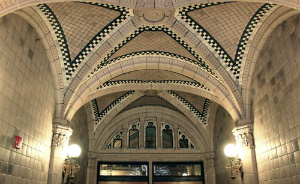By Bruce Moser, Class of 2001
The Michigan Avenue Street Wall is one of Chicago’s marvels—an ensemble of 50 mid and high-rise structures built between 1890 and 1930. CAC offers tours of several of these structures, the Monroe Building among them, allowing tour-takers to view their interiors.
The Monroe Building tour tells its story from its “birth” in 1912 to its rebirth 100 years later. The doors opened to tenants in May of 1912, less than a year after construction began. Ninety-five years later, Col. Jennifer Pritzker’s Tawani Enterprises bought the building and embarked on a five-year restoration. Tawani worked with 21st century successors to the 1912 suppliers to source legacy materials for the restoration. Fortunately, the successor architectural firm of Holabird and Root had access to the original Holabird and Roche drawings, which informed the restoration.
The Monroe Building tour has three distinct sections. First is the building itself, representing the end of the Chicago Commercial Style, defined as a tall metal-framed building from which is hung a curtain wall. The second section is a visit to Ceramica D’Imola, the tenant on the seventh floor. Finally, the Pritzker Military Museum and Library is housed on the second and third floors.
The handsome façade of the building features gray-pink granite on the first and second floors, contrasting with the mottled shades of gray-pink terra cotta that complete the cladding. The effect is an eclectic combination of Gothic and Italianate with Romanesque references within the gable.
The interior of the first-floor hallway and the vestibules are of Rockwood tile, a material peculiarly adapted to the paneled walls, the columns, and the groined ceilings. Historian Tim Samuelson has labeled the Rookwood tile lobby a built-in museum of ceramic art. The woodwork is dark English oak. Departing the elevator on many floors is like going back to 1912 when people were talking about the sinking of the Titanic in the North Atlantic and Alaska becoming a U.S. territory.
The Chicagology website comments, “There is not a more beautiful office building in Chicago than the Monroe Building.”
Ceramica’s North American headquarters occupies Suite 700. Ceramica was founded in 1874 near Bologna, Italy. When shopping for a U.S. location, the CEO was understandably dazzled by the Rookwood tile lobby. The view from the seventh-floor space and the Monroe’s proximity to the Art Institute convinced him that this was the ideal location for a wholesale showroom for architects and designers. Much of the Ceramic tile on display looks like wood or stone, much more durable than natural wood and stone. The view to the north discloses gargoyles and other architectural details of Holabird and Roche’s University Club across Monroe Street. Architects and designers on the tour sometimes engage Ceramica staff in conversation and have received samples, encouraging a follow-up visit.

The third section of the tour is of the Pritzker Military Museum and Library, which occupies the second and third floors. It began as a family collection of 7,500 books that has now grown to more than 50,000 books and 1,500 military-themed posters. On display are Medals of Honor and other military artifacts. In the Medal of Honor alcove, there’s a touch screen that accesses a database providing citations of over 1,000 Medal of Honor recipients.
The current display on these floors commemorates the centennial of the end of World War I. These displays rotate every two years.
The rear door of the Monroe is steps away from the 1903 Sharp building on Wabash Avenue in which Holabird and Roche perfected what came to be known as the Chicago Commercial Style. Directly across Monroe Street on Michigan Avenue is their 1909 University Club. Col. Pritzker’s cousin John Pritzker recently restored Henry Ives Cobb’s 1893 Chicago Athletic Association Building, now the popular hotel.
During Open House Chicago last October, visitors had a 30-minute tour of the Monroe lobby with an optional visit to the second and third floors. Visiting servicemen often went directly to these floors.
Several tour-takers noted that they’ve walked past the Monroe Building many times but never realized the lobby was so interesting. Some recall coming into the building many years ago to go to a dentist or doctor in the building. One woman mentioned that her grandfather had a medical office in the building; I found his name in a 1940 list of tenants.
On your 2019 list of resolutions, make visiting the Michigan Avenue Streetwall, and particularly the Monroe Building, a priority. You won’t regret it!!



